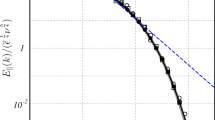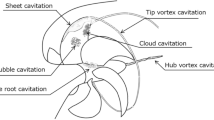Abstract
The vortical near wake of a model horizontal axis wind turbine has been investigated experimentally in a water channel. The objective of this work is to study vortex interaction and stability of the helical vortex filaments within a horizontal axis wind turbine wake. The experimental model is a geometrically scaled version of the Tjæreborg wind turbine, which existed in western Denmark in the late 1980s. Here, the turbine was tested in both the upwind and downwind configurations. Qualitative flow visualisations using hydrogen bubble, particle streakline and planar laser-induced fluorescence techniques were combined with quantitative data measurements taken using planar particle image velocimetry. Vortices were identified using velocity gradient tensor invariants. Parameters that describe the helical vortex wake, such as the helicoidal pitch, and vortex circulation, were determined for three tip speed ratios. Particular attention is given here to the root vortex, which has been investigated minimally to date. Signatures of the coherent tip vortices are seen throughout the measurement domain; however, the signature of the root vortex is only evident much closer to the rotor plane, irrespective of the turbine configuration. It is postulated that the root vortex diffuses rapidly due to the effects of the turbine support geometries.
















Similar content being viewed by others
References
Alam MM, Zhou Y, Yang H, Guo H, Mi J (2010) The ultra-low Reynolds number airfoil wake. Exp Fluids 48:81–103
Ameur K, Masson C, Eecen P (2011) 2D and 3D numerical simulation of the wind-rotor/nacelle interaction in an atmospheric boundary layer. J Wind Eng Ind Aerodyn. doi:10.1016/j.jweia.2011.06.002
Bandyopadhyay P, Stead D, Ash R (1991) The organized nature of a turbulent trailing vortex. AIAA J 29(10):1627–1633
Barthelmie R, Frandsen S, Rathmann O, Hansen K, Politis E, Prospathopoulos J, Schepers J, Rados K, Cabezón D, Schlez W, Neubert A, Heath M (2011) Flow and wakes in large wind farms: final report for upwind wp8. Tech. Rep. Risø-R-1765(EN), Risø DTU, National Laboratory for Sustainable Energy
Beresh S, Henfling J, Spillers R (2010) Meanser of a fin trailing vortex and the origin of its turbulence. Exp Fluids 49(3):599–611
Blevins R (1984) Applied fluid dynamics handbook. Van Nostrand Reinhold company, New York
Carmer C, Konrath R, Schroder A, Monnier J-C (2008) Identification of vortex pairs in aircraft wakes from sectional velocity data. Exp Fluids 44:367–380
Chakraborty P, Balachandar S, Adrian R (2005) On the relationships between local vortex identification schemes. J Fluid Mech 535:189–214
Chong M, Perry A, Cantwell B (1990) A general classification of three-dimensional flow fields. Phys Fluids A 2(5):765–777
Crespo A, Hernández J, Frandsen S (1999) Survey of modelling methods for wind turbine wakes and wind farms. Wind Energy 2:1–24
Devenport W, Rife M, Liapis S, Follin G (1996) The structure and development of a wing tip vortex. J Fluid Mech 312:67–106
Dobrev I, Maalouf B, Troldborg N, Massouh F (2008) Investigation of the wind turbine vortex structure. 14th international symposium on applications of laser techniques to fluid mechanics, Lisbon, Portugal, 07–10 July 2008
Ebert P, Wood D (1997) The near wake of a model horizontal-axis wind turbine, part 1. Experimental arrangements and initial results. Renew Energy 12(3):225–243
Ebert P, Wood D (1999) The near wake of a model horizontal-axis wind turbine, part 2. General features of the three-dimensional flowfield. Renew Energy 18:513–534
Ebert P, Wood D (2001) The near wake of a model horizontal-axis wind turbine, part 3. Properties of the tip and hub vortices. Renew Energy 22:461–472
Felli M, Camussi R, Felice FD (2011) Mechanisms of evolution of the propeller wake in the transition and far fields. J Fluid Mech 682:5–53
Fouras A, Soria J (1998) Accuracy of out-of-plane vorticity measurements derived from in-plane velocity field data. Exp Fluids 25:409–430
Fouras A, Lo Jacono D, Hourigan K (2008) Target free stereo piv: a novel technique with inherent error estimation and improved accuracy. Exp Fluids 44:317–329
Glauert H (1937) The elements of airfoil and airscrew theory. Cambridge University Press, London
Grant I, Owens E (1990) Confidence interval estimates in PIV measurements of turbulent flows. Appl Opt 29(10):1400–1402
Grant I, Parkin P (2000) A DPIV study of the trailing vortex elements from the blades of a horizontal axis wind turbine in yaw. Exp Fluids 28:368–376
Gupta B, Loewy R (1974) Theoretical analysis of the aerodynamic stability of multiple, interdigitated helical vortices. AIAA J 12(10):1381–1387
Haans W, van Kuik G, van Bussel G (2008) The inverse vortex wake model: a measurement analysis tool. J Solar Eng 130:1–14
Hansen K, Barthelmie R, Jensen L, Sommer A (2012) The impact of turbulence intensity and atmospheric stability on power deficits due to wind turbine wakes at horns rev wind farm. Wind Energy 15:183–196
Hansen M (2008) Aerodynamics of wind turbines, 2nd edn. Earthscan, London
Heyes A, Hones R, Smith D (2004) Wandering of wing-tip vortices. In: Proceedings of 12th international symposium on the applications of laser techniques to fluid mechanics. Lisbon, Portugal
Horton H (1968) Laminar separation bubbles in two and three-dimensional incompressible flow. PhD, University of London
Ivanell S, Sørensen J, Mikkelsen R, Henningson D (2009) Analysis of numerically generated wake structures. Wind Energy 12:63–80
Ivanell S, Mikkelsen R, Sørensen J, Henningson D (2010) Stability analysis of the tip vortices of a wind turbine. Wind Energy 13(8):705–715
Jacobs E, Sherman A (1937) Airfoil section characteristics as affected by variations of the Reynolds number. Tech. Rep. Report No. 586, National advisory committee for aeronautics
Masson C, Smaïli A (2006) Numerical study of turbulent flow around a wind turbine nacelle. Wind Energy 9:281–298
Medici D, Alfredsson P (2006) Measurements on a wind turbine wake: 3D effects and bluff body vortex shedding. Wind Energy 9:219–236
Micallef D, Akay B, Saint T, Ferreira C, van Bussel G (2011) Experimental and numerical study of radial flow and its contribution to wake development of a HAWT. In: Proceedings of the European wind energy association
Okulov V, Sørensen J (2007) Stability of helical tip vortices in a rotor far wake. J Fluid Mech 576:1–25
Øye S (1990) Tjæreborg wind turbine (Esbjerg) geometric and operational data. Tech. Rep. AFM-NOTAT VK-184, Department of fluid mechanics, DTH
Øye S (1991) Tjæreborg wind turbine (Esbjerg), first dynamic inflow measurement. Tech. Rep. AFM-NOTAT VK-189, Department of fluid mechanics, DTH
Raffel M, Willert C, Kompenhans J (eds) (1998) Particle image velocimetry—a practical guide. Springer, Heidelberg, pp 51–58; 182–189
Roy C, Leweke T, Thompson M, Hourigan K (2011) Experiments on the elliptic instability in vortex pairs with axial core flow. J Fluid Mech 677:383–416
Schepers J, Snel H (2007) Model experiments in controlled conditions, final report. Tech. Rep. ECN-E–07-042, Energy research centre of the Netherlands
Selig M, Guglielmo J, Broeren A, Giguére P (1995) Summary of low-speed airfoil data, vol 1. SoarTech Publications, Virginia Beach, VA
Shen W, Mikkelsen R, Sørensen J (2005) Tip loss corrections for wind turbine computations. Wind Energy 8:457–475
Sørensen J (2011) Aerodynamics aspects of wind energy conversion. Annu Rev Fluid Mech 43:427–448
Sunada S, Kawachi K (2002) Comparison of wing characteristics at an ultralow Reynolds number. J Aircr 39(2):331–338
Vermeer L, Sørensen J, Crespo A (2003) Wind turbine wake aerodynamics. Prog Aerosp Sci 39:467–510
Vollmers H (2001) Detection of vortices and quantitative evaluation of their main parameters from experimental velocity data. Meas Sci Technol 12:1199–1207
Walther J, Guenot M, Machefaux E, Rasmussen J, Chatelain P, Okulov V, Sørensen J, Bergdof M, Koumoutsakos P (2007) A numerical study of the stability of helical vortices using vortex methods. J Phys Conf Ser 75:012034
Whale J (1996) A study of the near wake of a model wind turbine using particle image velocimetry. PhD, The University of Edinburgh
Whale J, Helmis C, Papadopolous K, Anderson C, Skyner D (1996) A study of the near wake structure of a wind turbine comparing measurements from laboratory and full scale measurements. Sol Energy 56(6):621–633
Whale J, Anderson C, Bareiss R, Wagner S (2000) An experimental and numerical study of the vortex structure in the wake of a wind turbine. J Wind Eng Ind Aerodyn 84:1–21
Widnall S (1972) The stability of a helical vortex filament. J Fluid Mech 54(4):641–663
Yoshida S (2006) Performance of downwind turbines in complex terrain. Wind Eng 30(6):487–502
Zahle F, Sørensen N (2011) Characterisation of the unsteady flow in the nacelle region of a modern wind turbine. Wind Energy 14:271–283
Zhou J, Adrian R, Balachandar S, Kendall T (1999) Mechanisms for generating coherent packets of hairpin vortices in channel flow. J Fluid Mech 387:353–396
Author information
Authors and Affiliations
Corresponding author
Rights and permissions
About this article
Cite this article
Sherry, M., Sheridan, J. & Jacono, D.L. Characterisation of a horizontal axis wind turbine’s tip and root vortices. Exp Fluids 54, 1417 (2013). https://doi.org/10.1007/s00348-012-1417-y
Received:
Revised:
Accepted:
Published:
DOI: https://doi.org/10.1007/s00348-012-1417-y




